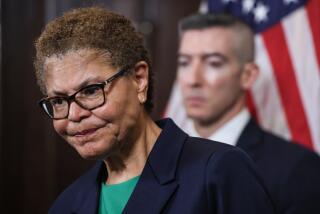Grass-Roots Effort Helps Pull Camarillo Schools Out of Fiscal Quagmire
- Share via
A year ago, Camarillo’s Pleasant Valley School District was reeling from the discovery that its budget was $600,000 in the red, forcing drastic cuts in school maintenance, educational supplies and equipment purchases.
But, as school resumes this year, the district, aided by substantial contributions of parents and employees, has pulled itself out of the red and appears headed for solid financial ground.
School officials say that parents should not have to hold bake sales and teachers should not have to purchase their own paper and pencils to get by this year.
“I think we are headed in the right direction,” said Carmela Vignocchi, the district’s director of budget and fiscal services. “We’ve gone 180 degrees from last year to this year.”
But the district is still not fully recovered. For example, its beginning surplus--in effect, a savings account that can be used to pay for unplanned expenses--is $418,000, only about half of what it was two or three years ago, Vignocchi said.
6% Increase
The district’s budget, approved last week, totals slightly more than $15 million, an increase of about 6% from last year.
The 5,530-student district, which operates 11 elementary and two junior high schools, was thrown into turmoil in June, 1984, when officials discovered that too much money in a reserve fund had been spent and not enough remained to cover a just-negotiated employee pay raise.
District officials dipped into various accounts to fund the pay increase and other expenses, but that led to a variety of cutbacks, including a reduction in the purchase of basic supplies. The situation was so bad, one PTA leader complained, that the district was faced with deciding whether to “buy toilet paper or ditto paper.”
As the 1984-85 school year progressed, though, school board members, staff, employees and parents pitched in to help improve the district’s financial condition and to provide the materials needed by students.
At Monte Vista Junior High School, for example, teachers and staff cut down on photocopying, slashing the number of monthly copies from 60,000 to 25,000, Vignocchi said.
Scavenging Parts
Instead of buying audio-visual equipment or replacement parts, they scavenged parts from old, non-functioning projectors and amplifiers.
Several parent groups organized fund-raisers, such as bake sales, “jog-a-thons” and carnivals, to buy student workbooks and fix a copying machine, among other things. A local firm donated unused computer paper that children could use for coloring or that secretaries could use for taking notes.
Los Altos Intermediate School collected cash and goods worth $17,580, district spokeswoman Lynne Carey said.
“Camarillo is lucky,” said Kathy Auth, president of the Camarillo PTA Council. “Most of the parents can go to K-Mart and buy pencils and paper. But it’s not the kind of thing you want to go on forever.”
Whereas the grass-roots efforts helped the schools cope with the immediate crisis, major moves by the school board helped improve the overall financial picture.
In November, the district joined a medical insurance plan with other Ventura County school districts, saving $250,000, Vignocchi said. That same month, the school board approved a plan to sell tax-free bonds, income from which tided the district over some particularly difficult months earlier this year.
The district also cut back on calling substitute custodians and secretaries when regular employees called in sick.
“We were upset about it,” said Alice Richards, president of the union local representing non-credentialed employees. “But we understood the district had a problem, and everybody tried to help and work it out.”
School officials were also pleasantly surprised when income from the rental of school facilities was greater than anticipated, as was the allocation from the state for pupil transportation, Vignocchi said.
District officials contend that the students’ education did not suffer because of the financial troubles.
Union View
But Aileen Tyner, president of the teachers union, was not as positive in her appraisal, pointing to the inability to buy any educational films. Tyner also said that morale among teachers was low and that supplies did not come in quickly enough or in the quantity needed.
At first, the district projected that it would be able to spend only $8.20 per student for instructional materials in the 1984-85 year, a drop from about $20 the previous year. But the maneuverings by the school board and staff increased the figure to $28 by the end of the 1984-85 year, Vignocchi said.
This year, $32 to $36 per student is budgeted for educational supplies, a figure that will probably rise as the year progresses, he said.
Shifting of Funds
In addition, a fund to purchase chalkboards, lawn mowers, lunch tables and other equipment, slashed last year because of the financial turmoil, contains $73,748. The money was shifted from another account, which in turn will be replenished from expected state lottery revenues, Vignocchi said.
The district’s efforts apparently have satisfied county school officials. They required monthly budget reports from the district last year but are expected to soon modify that and require only routine quarterly reports this year.
District officials say they hope the state won’t allocate less money than anticipated this year for reimbursement of state-mandated programs.
“We’re just tight,” Vignocchi said. “We’ll have to pay attention to every expense.”
More to Read
Sign up for Essential California
The most important California stories and recommendations in your inbox every morning.
You may occasionally receive promotional content from the Los Angeles Times.










